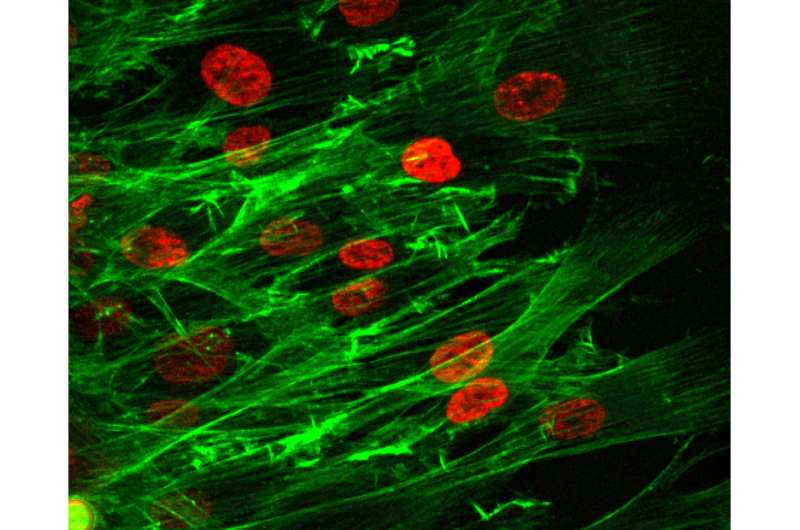Findings probe cell cooperation, 'en masse' migration

New research findings are revealing secrets about how living cells "cooperate" with each other, joining into groups that migrate collectively and alter tissue.
The research focused on cells called fibroblasts, which are found in connective tissue and produce the "extracellular matrix," a scaffold-like material between cells in living tissue.
"Fibroblast migration plays a key role during various physiological and pathological processes such as wound healing and cancer metastasis," said Bumsoo Han, a Purdue University professor of mechanical and biomedical engineering. "Although migration of individual fibroblasts has been well studied, migration in-vivo often involves simultaneous locomotion of groups of fibroblasts, so-called 'en masse migration."
New findings were published in October in the Journal of the Royal Society Interface.
"Specifically, we hypothesized that a group of migrating cells can significantly deform the matrix, whose mechanical microenvironment dramatically changes compared with the un-deformed state," he said. "Because the cells cooperate, they can exert greater force in deforming the matrix compared to single cells alone. The alteration of the matrix microenvironment reciprocally affects cell migration."
The hypothesis was tested by measuring the extracellular matrix deformation during en masse migration on collagen "hydrogels." Findings showed the grouped cells act collectively to deform the matrix before and during the migration.
"We found that cells on soft collagen hydrogels migrate along tortuous paths, but, as the matrix stiffness increases, cell migration patterns become aligned with each other and show coordinated migration paths," he said.
The research is related to work led by Andrew Mugler, a Purdue assistant professor of physics and astronomy, who co-authored a recent paper in the journal Physical Review Letters. The two researchers have collaborated for about two years.
"The common theme of both papers is how these cells cooperate," Han said.
Findings will aid efforts to learn more about the en masse cell migration and its relationship to processes including cancer metastasis.
The Interface paper's lead author is Purdue graduate student Altug Ozcelikkale. That paper probes how the cells "cooperate mechanically," while the PRL paper focuses on how they cooperate chemically, Han said.
The research is ongoing, with future work investigating the multiple chemical and environmental cues involved in the collective cell behavior.
More information: Altug Ozcelikkale et al. Effects of dynamic matrix remodelling on en masse migration of fibroblasts on collagen matrices, Journal of The Royal Society Interface (2017). DOI: 10.1098/rsif.2017.0287
Journal information: Journal of the Royal Society Interface , Physical Review Letters
Provided by Purdue University



















